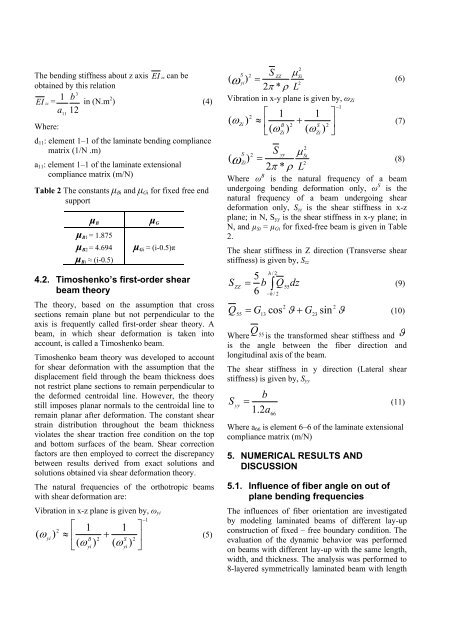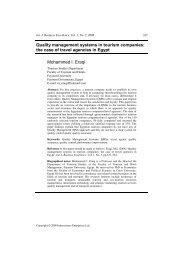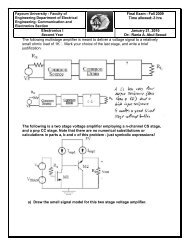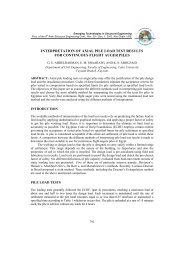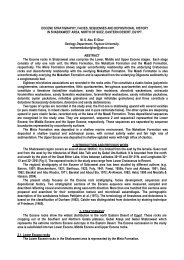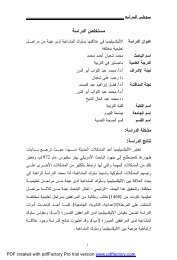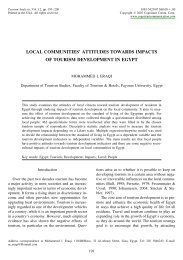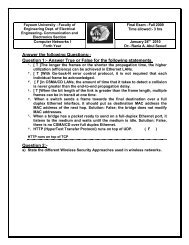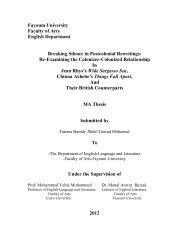EFFECTS OF FIBER ORIENTATION AND LAMINATE STACKING ...
EFFECTS OF FIBER ORIENTATION AND LAMINATE STACKING ...
EFFECTS OF FIBER ORIENTATION AND LAMINATE STACKING ...
You also want an ePaper? Increase the reach of your titles
YUMPU automatically turns print PDFs into web optimized ePapers that Google loves.
The bending stiffness about z axis EI zz can be<br />
obtained by this relation<br />
EI zz =<br />
Where:<br />
3<br />
1 b<br />
in (N.m<br />
a 12<br />
2 ) (4)<br />
11<br />
d11: element 1–1 of the laminate bending compliance<br />
matrix (1/N .m)<br />
a11: element 1–1 of the laminate extensional<br />
compliance matrix (m/N)<br />
Table 2 The constants μBi and μGi for fixed free end<br />
support<br />
μB<br />
μB1 = 1.875<br />
μB2 = 4.694<br />
μBi ≈ (i-0.5)<br />
μG<br />
μGi ≈ (i-0.5)π<br />
4.2. Timoshenko’s first-order shear<br />
beam theory<br />
The theory, based on the assumption that cross<br />
sections remain plane but not perpendicular to the<br />
axis is frequently called first-order shear theory. A<br />
beam, in which shear deformation is taken into<br />
account, is called a Timoshenko beam.<br />
Timoshenko beam theory was developed to account<br />
for shear deformation with the assumption that the<br />
displacement field through the beam thickness does<br />
not restrict plane sections to remain perpendicular to<br />
the deformed centroidal line. However, the theory<br />
still imposes planar normals to the centroidal line to<br />
remain planar after deformation. The constant shear<br />
strain distribution throughout the beam thickness<br />
violates the shear traction free condition on the top<br />
and bottom surfaces of the beam. Shear correction<br />
factors are then employed to correct the discrepancy<br />
between results derived from exact solutions and<br />
solutions obtained via shear deformation theory.<br />
The natural frequencies of the orthotropic beams<br />
with shear deformation are:<br />
Vibration in x-z plane is given by, ωyi<br />
(<br />
yi<br />
)<br />
⎡<br />
1<br />
1<br />
)<br />
2<br />
≈ ⎢ + B 2 S<br />
( ω yi ) ( ω yi<br />
ω (5)<br />
⎣<br />
2<br />
⎤<br />
⎥<br />
⎦<br />
−1<br />
μ<br />
2π<br />
* ρ L<br />
2<br />
S 2 S ZZ Si<br />
ω ) = (6)<br />
yi<br />
2<br />
(<br />
Vibration in x-y plane is given by, ωZi<br />
2 ⎡ 1 1 ⎤<br />
( ω Zi ) ≈ ⎢ + 2 S 2<br />
( ) ( )<br />
⎥<br />
(7)<br />
B<br />
⎣ ωZi<br />
ωZi<br />
⎦<br />
2<br />
S S 2<br />
yy μSi<br />
ω ) = (8)<br />
Zi<br />
2<br />
(<br />
2π<br />
* ρ L<br />
Where ω B is the natural frequency of a beam<br />
undergoing bending deformation only, ω S is the<br />
natural frequency of a beam undergoing shear<br />
deformation only, Szz is the shear stiffness in x-z<br />
plane; in N, Syy is the shear stiffness in x-y plane; in<br />
N, and µSi = µGi for fixed-free beam is given in Table<br />
2.<br />
The shear stiffness in Z direction (Transverse shear<br />
stiffness) is given by, Szz<br />
/ 2 5<br />
= ∫ 55<br />
6<br />
h<br />
S b Q dz<br />
(9)<br />
ZZ<br />
−h<br />
/ 2<br />
2<br />
2<br />
Q = G cos ϑ + G sin ϑ<br />
(10)<br />
55 13<br />
23<br />
Q<br />
Where 55 is the transformed shear stiffness and ϑ<br />
is the angle between the fiber direction and<br />
longitudinal axis of the beam.<br />
The shear stiffness in y direction (Lateral shear<br />
stiffness) is given by, Syy<br />
b<br />
S yy = (11)<br />
1. 2a<br />
66<br />
Where a66 is element 6–6 of the laminate extensional<br />
compliance matrix (m/N)<br />
−1<br />
5. NUMERICAL RESULTS <strong>AND</strong><br />
DISCUSSION<br />
5.1. Influence of fiber angle on out of<br />
plane bending frequencies<br />
The influences of fiber orientation are investigated<br />
by modeling laminated beams of different lay-up<br />
construction of fixed – free boundary condition. The<br />
evaluation of the dynamic behavior was performed<br />
on beams with different lay-up with the same length,<br />
width, and thickness. The analysis was performed to<br />
8-layered symmetrically laminated beam with length


